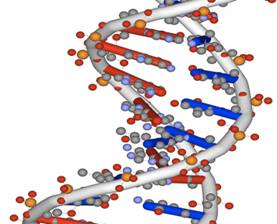Sixty "de novo" genes, many active in the cerebral cortex, arose from once-quiet stretches of DNA after humans split off from chimpanzees more than five million years ago
Billions of years ago, organic chemicals in the primordial soup somehow organized themselves into the first organisms. A few years ago scientists found that something similar happens every once in awhile in the cells of all living things: bits of once-quiet stretches of DNA sometimes spontaneously assemble themselves into genes. Such "de novo" genes may go on to play significant roles in the evolution of individual organisms—even humans. But how many are there?
More than anyone thought, it turns out.
The most prolific source of new genes in animals, plants, fungi and other life whose cells have nuclei involves the shuffling or duplication of bits of DNA from existing genes. It was widely thought that de novo evolution of genes was quite rare, because the proteins they code for are often large and complex—most fail to function properly if a single key component is out of place, so randomly evolving a working gene seemed implausible.
When an international team of researchers scanned the human genome for de novo genes, however, they putatively uncovered 60, three times more than once estimated. More surprising, many of these genes are active in the cerebral cortex, suggesting that de novo genes might have played a key role in the evolution of the human mind.
"The cerebral cortex in the brain plays key roles in learning, memory, language, thought, emotion, perceptual awareness and consciousness," says researcher Dong-Dong Wu, a geneticist at the Chinese Academy of Science's Kunming Institute of Zoology, co-author of a November 10 report inPloS Genetics. "Our results suggest that de novo–originated genes may be responsible for some of these characters."
A flurry of research in the past five years also had suggested that recent de novo evolution of genes was not impossible. De novo genes were first discovered in fruit flies, and have since been seen in yeast, rice, mice and primates. They were first reported in humans in 2009.
To find more de novo human genes, Wu and his team started with known human genes and eliminated those resembling genes in other primate lineages. Then they excluded human genes that also exist in primate relatives, but are disabled. The resulting 60 de novo genes were short and relatively simple. They were found to be active in a variety of tissues, including fat, lung, colon, breast, liver, muscle and lymph, but were most active in the testes and the cerebral cortex.
Sixty might not seem much given the 20,000 to 25,000 genes making up the human genome, but "we didn't used to think there were any," says geneticist Aoife McLysaght at Trinity College Dublin, who did not take part in this study. Given this number and the length of time between the split of human and chimpanzee lineages five million to six million years ago, the rate of origin of de novo genes seems to be approximately 10 to 12 such genes per million years, three times higher than past estimates from McLysaght and others suggested.
On the other hand, all the de novo genes were active only at relatively low levels in the tissues analyzed. "Thus, it could be argued that they play only weak biological roles," Wu notes. It remains uncertain what functions they do have—for instance, the researchers have not yet linked mutations of these genes with any known diseases.
Discovering what roles the de novo genes play will likely prove difficult. Tinkering with these genes in lab-grown cells might shed light on their activity, but the effects might be subtle at best and perhaps only seen at the larger scales of tissues and organs. Researchers, of course, cannot perform experiments on people, and it may prove impossible to perform effective experiments on lab animals to which these human genes are introduced; the de novo genes may have to interact with partner genes to function properly. One could try figuring out what other genes these de novo genes interact with to get an idea of what they might do, McLysaght suggests.
Another line of future research may be to search for de novo genes across an entire group of organisms, such as primates. "Can we say de novo mutations happen more often in humans, and if so, why?" McLysaght says. "Also, if we find older examples of de novo genes that occurred earlier in our family tree and are shared by several descendant species, we can study how these genes evolve over time, and by seeing what they do in related species, we might be able to discover what they do in us."

(Image: ghutchis, courtesy Flickr)
(Scientific American, Charles Q. Choi)
Editor’s note: the research results are come from the Dr. ZHANG Ya-Ping’s research group of Kunming Institute of Zoology, the Chinese Academy of Sciences. The relevant article can be found by the following link: http://www.plosgenetics.org/article/info%3Adoi%2F10.1371%2Fjournal.pgen.1002379. The relevant perspective article from PloS One genetics can be found by the following link: http://www.plosgenetics.org/article/info%3Adoi%2F10.1371%2Fjournal.pgen.1002381
